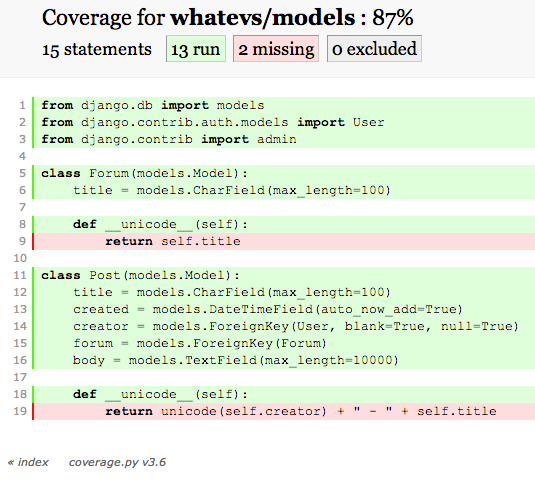Testing in Django (Part 2)
In the last post, I introduced you to testing in Django and we looked at best practices as well as a few examples. This time, I’ll show you a bit more complicated example and introduce you to Model Mommy for creating sample data.
Why Should You Care?
In the last post, I said that, “factory_boy, model_mommy
To summarize, the Django Testing Fixtures are problematic because they:
- must be updated each time your model/schema changes,
- are really, really slow; and
- sometimes hard-coded data can cause your tests to fail in the future.
So, by using Model Mommy you can create fixtures that load quicker and are much easier to maintain over time.
Django Testing Fixtures
Let’s start by looking at our example for testing the model in the last post:
class WhateverTest(TestCase): def create_whatever(self, title="only a test", body="yes, this is only a test"): return Whatever.objects.create( title=title, body=body, created_at=timezone.now()) def test_whatever_creation(self): w = self.create_whatever() self.assertTrue(isinstance(w, Whatever)) self.assertEqual(w.__unicode__(), w.title)
Here we simply created a Whatever() object and asserted that the created title matched the expected title.
If you downloaded the Project from the repo, fire up the server and run the tests:
$ coverage run manage.py test whatever -v 2
You will see that the above tests pass:
test_whatever_creation (whatever.tests.WhateverTest) ... ok
Now, instead of having to create a new instance, with each attribute, each time (boring!), we can use Model Mommy to streamline the process.
Model Mommy
Install:
$ pip install model_mommy
Remember what our model looks like?
class Whatever(models.Model): title = models.CharField(max_length=200) body = models.TextField() created_at = models.DateTimeField(auto_now_add=True) def __unicode__(self): return self.title
Now we can re-write the above test in a much easier fashion:
from model_mommy import mommy class WhateverTestMommy(TestCase): def test_whatever_creation_mommy(self): what = mommy.make(Whatever) self.assertTrue(isinstance(what, Whatever)) self.assertEqual(what.__unicode__(), what.title)
Run it. Did it pass?
How easy was that? No need to pass in arguments.
New Model
Let’s look at a bit more complicated example.
Setup
Create a new app:
$ python manage.py startapp whatevs
Add the app to the Installed_Apps in the settings.py file
Create the model:
from django.db import models from django.contrib.auth.models import User from django.contrib import admin class Forum(models.Model): title = models.CharField(max_length=100) def __unicode__(self): return self.title class Post(models.Model): title = models.CharField(max_length=100) created = models.DateTimeField(auto_now_add=True) creator = models.ForeignKey(User, blank=True, null=True) forum = models.ForeignKey(Forum) body = models.TextField(max_length=10000) def __unicode__(self): return unicode(self.creator) + " - " + self.title
Sync the DB.
What does our coverage report look like?
Test
Add the tests:
from model_mommy import mommy from django.test import TestCase from whatevs.models import Forum, Thread class WhateverTestMommy(TestCase): def test_forum_creation_mommy(self): new_forum = mommy.make('whatevs.Forum') new_thread = mommy.make('whatevs.Thread') self.assertTrue(isinstance(new_forum, Forum)) self.assertTrue(isinstance(new_thread, Thread)) self.assertEqual(new_forum.__unicode__(), new_forum.title) self.assertEqual( new_thread.__unicode__(), (str(new_thread.forum) + " - " + str(new_thread.title)))
Re-run your tests (which should pass), then create the coverage report:
$ coverage run manage.py test whatevs -v 2 $ coverage html
Well?
Care to try running the above tests using JSON fixtures to see just how to set the tests up using the Django Testing Fixtures?
I’m not sure what we’ll have in store for the next tutorial, so let me know what you’d like to see. Grab the code here. Be sure to comment below if you have questions. Cheers!

